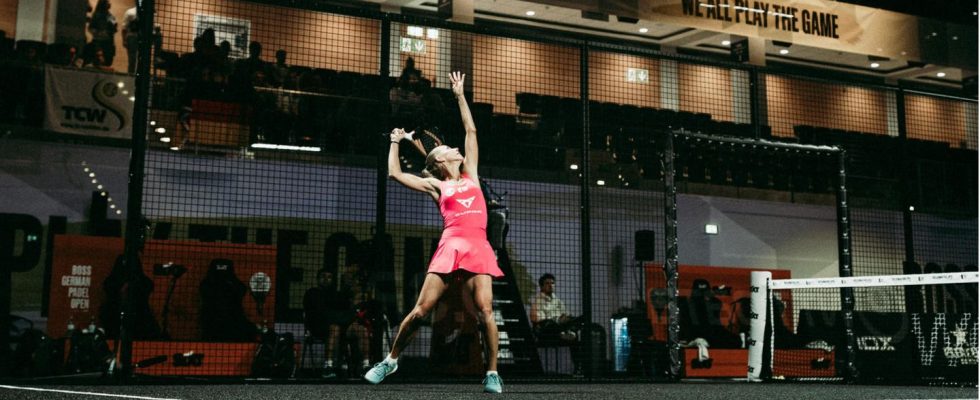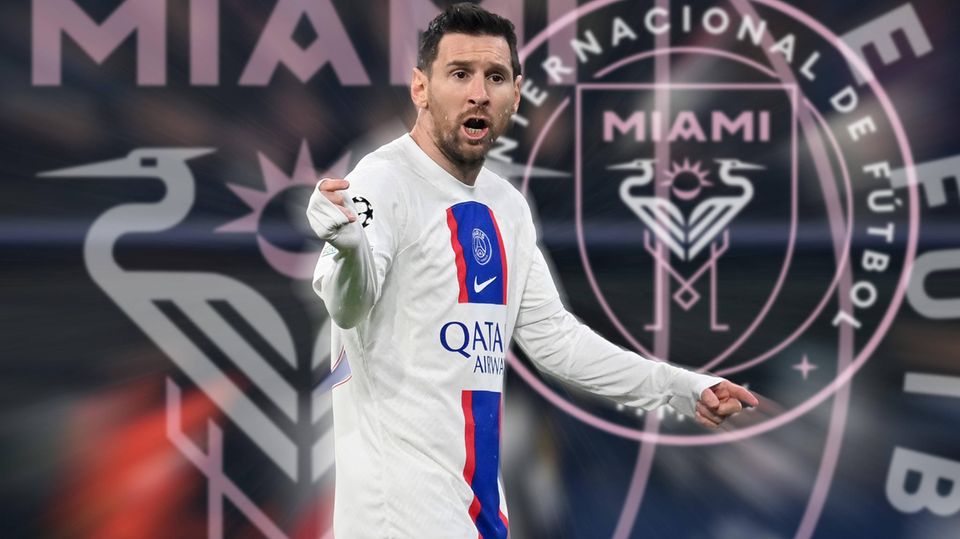The trend sport padel has not yet achieved a breakthrough in Germany. It is supported by major sponsors and start-ups invest millions. Now the World Padel Tour is visiting Germany for the first time and should finally draw attention to the sport
The rows of seats are lit yellow. Loud music rumbles through the whole body. When it goes out, there is the dull sound of a bat hitting a felt ball. If there were a net in the middle of the arena instead of a cage, it would be a typical tennis match. But it is a new trend sport: Padel.
The first match with German participation has just started. Daniel Lingen and Vincent Jülich meet top 20 players Miguel Yanguas and Fernando Belasteguín. It is a first for the Germans to play against the world elite in front of a home crowd at such an important tournament. With the German Padel Open in Düsseldorf, a World Padel Tour (WPT) tournament, comparable to the ATP tour in tennis, is taking place in Germany for the first time. They offer the top German players an exceptionally large stage – and also the trend sport of padel as a whole, which is still relatively unknown here. The sponsor presence is great. Facilities are being built all over Germany and everyone in the scene agrees that padel has economic potential in this country.
The attention for padel is increasing
Padel is a racket sport, a mixture of tennis and squash. The court, called a “cage,” is smaller than that used for tennis and is surrounded by glass walls with metal struts that are incorporated into the game. In the Düsseldorf event location, the orange benches for the players stand out next to the cage. The seats mounted on it are reminiscent of cars: no coincidence, the car rental company Sixt is one of the main sponsors. The name for the tournament comes from the fashion company Hugo Boss. The advertising boards mainly feature advertising from Spanish companies, such as the beer brand Estrella Damm or the sports equipment manufacturer Nox. The Cupra car brand is also present: with a model next to the Center Court, a large advertising stand in front of the entrance and the logo on the clothing of many players.
The VW subsidiary from Spain has been active internationally in padel sports for four years and is a premium partner of all official World Padel Tour tournaments until at least 2024. Internationally, the reach is of course greater than in Germany, the company said in response to Capital’s request. But here too, the car manufacturer estimates the growth of the sport to be almost exponential and does not consider padel – like many other trend sports – a “flash in the pan”.
Padel has been on the rise in Germany in recent years, but the sport from Spain has still not achieved a breakthrough. There are currently around 300 places in this country. In Spain, where padel is already more popular than tennis and one in ten people plays regularly, there are more than 20,000 of them. And Germany’s neighboring countries are also developing much faster; in Sweden, for example, there are already around 4,000 places.
“The others are four or five years ahead of us. But padel is becoming more and more popular in Germany,” says Victoria Kurz, one of the active players in Düsseldorf, in an interview with Capital. “We hope that padel will gain more exposure this week and that more people on the street will know what it actually is.” Kurz and her partner Denise Höfer are currently the best German women’s doubles, both wearing a colorful sports outfit consisting of a shirt and skirt. You have already taken part in world championships and travel a lot internationally. However, they don’t earn millions of dollars with it: at a tournament on the WPT tour like this one in Düsseldorf, the prize money in the main draw is around 500 euros, they say. But German players usually don’t make it into the main draw. Pairs from Spain and Argentina, who train under much more professional conditions, dominate the world’s best. In Düsseldorf, some German pairings received a wildcard.

Denise Höfer, 42, (left) and Victoria Kurz, 24, are currently the best German women’s doubles in padel
Kurz and Höfer usually earn 100 to 200 euros at a tournament. “You first have to get to the point where you can cover the costs of travel, hotels and so on,” says Höfer, who is also self-employed with a sports marketing company. “The prize money helps to some extent, but we mainly cover the costs with the help of sponsors.” Cupra is also one of their big sponsors and, for example, provides them with a car that they use to train.
“The breakthrough is imminent”
The four best couples are estimated to earn over 1 million euros with sponsorship money. In Spain, padel professionals are invited to television shows and are real stars. Germany is miles away from that, but the two players notice that the more popular padel becomes in this country and the more attention their international appearances receive, the more requests for sponsorship they receive. “The popularity of sport in Germany brings us a lot from a sporting perspective, including financially,” says Kurz. Stefanie Steible from the German Padel Association (dpv) confirms to Capital that sponsorship requests are increasing. “It creates new opportunities,” she says. “But we also want to grow healthily.”
From the point of view of many experts, there is definitely growth potential, especially because the German market is still lagging behind in international comparison. But what is crucial for the breakthrough is that padel reaches the mainstream. After all: “There are so many places being built right now and people are curious,” says Höfer. “They look at it, want to know what’s happening and, ideally, they try it out.” In fact, the construction of padel facilities has picked up speed in recent months. According to dpv, the number of places has almost doubled in the last year alone, and investments are expected to be in a similar range.
This year, the start-up Padelcity, co-founded by former national coach Hansi Flick in 2022, opened several new facilities. With the founders’ investment and a first round of financing, it says it has already raised more than 4 million euros. And the company’s course is clear: growth. “Germany can certainly handle 8,000 to 10,000 courts,” says co-founder Jonathan Sierck to Capital. “We are currently assuming around 15,000 to 20,000 active players, with the number increasing sharply from month to month.” In his opinion, the next two to three years are decisive. “The breakthrough is imminent, I am absolutely convinced of that,” he says.
Daniel Lingen clearly lost his match – although Kurz and Höfer cheered loudly from the audience. In terms of play, he himself says clearly, even the best Germans cannot keep up with the world’s best. Lingen is Germany’s most experienced top padel player and has already taken part in three world and four European championships. “We’re all only semi-professionals,” he said in the Capital interview after the defeat. He still expects a lot from the tournament in Germany. “This is a huge opening and everyone in the scene notices that something is happening,” he says. “Now there are new tournaments and sponsors, there is more money in it. And the more money there is, the more potential the sport has in the long term.”
In Düsseldorf, world-class matches continue until the evening. On this “German day” Although there were only a few spectators on site on Wednesday, according to the organizers, more than 4,000 tickets were sold for the entire tournament. In addition, padel was broadcast on German television for the first time with this tournament. “The switch was flipped,” says Lingen – both literally and figuratively. “Padel is coming now.”
Note: This article first appeared on Capital.de.


